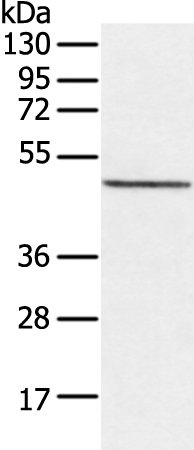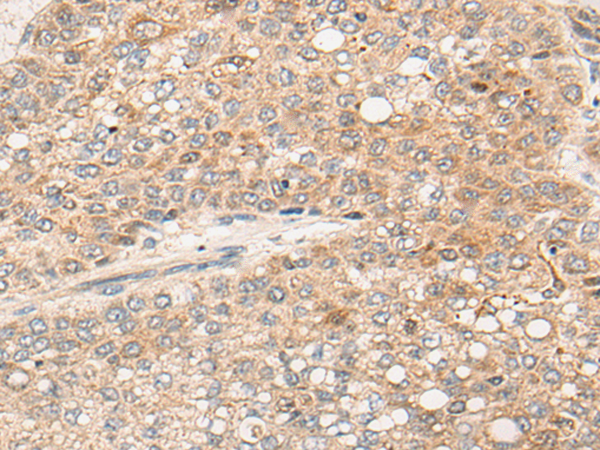

| WB | 咨询技术 | Human,Mouse,Rat |
| IF | 咨询技术 | Human,Mouse,Rat |
| IHC | 1/200 - 1/1000 | Human,Mouse,Rat |
| ICC | 技术咨询 | Human,Mouse,Rat |
| FCM | 咨询技术 | Human,Mouse,Rat |
| Elisa | 1/10000 | Human,Mouse,Rat |
| Aliases | DIA1R; CXorf36; PRO3743; EPQL1862; bA435K1.1; 4930578C19Rik |
| WB Predicted band size | 49 kDa |
| Host/Isotype | Rabbit IgG |
| Antibody Type | Primary antibody |
| Storage | Store at 4°C short term. Aliquot and store at -20°C long term. Avoid freeze/thaw cycles. |
| Species Reactivity | Human, Mouse |
| Immunogen | Synthetic peptide of human DIPK2B |
| Formulation | Purified antibody in PBS with 0.05% sodium azide and 50% glycerol. |
+ +
以下是关于CD10抗体的3篇代表性文献的简要总结:
---
1. **文献名称**: *CD10 is a marker for cycling cells with propensity to B-cell lymphomas*
**作者**: Greaves, M.F., et al.
**摘要**: 该研究揭示了CD10在正常B细胞分化过程中的表达动态,并发现其在快速增殖的B细胞中高表达,提示CD10可作为B细胞淋巴瘤(如伯基特淋巴瘤)的诊断标志物,尤其在区分白血病亚型中具有重要价值。
---
2. **文献名称**: *CD10 expression in stromal cells of renal cell carcinoma: a potential diagnostic pitfall*
**作者**: Arber, D.A., et al.
**摘要**: 通过免疫组化分析,作者发现CD10不仅在肾癌细胞中表达,也存在于肿瘤相关基质细胞中。研究强调在实体瘤诊断中需注意CD10的分布,避免因基质染色导致误诊,并探讨了其在肾癌鉴别诊断中的应用。
---
3. **文献名称**: *CD10/NEP in non-small cell lung carcinoma: stromal expression and prognostic significance*
**作者**: Sorensen, K.D., et al.
**摘要**: 该研究分析了CD10在非小细胞肺癌(NSCLC)肿瘤微环境中的表达,发现其与血管生成和基质重塑相关。高CD10表达提示患者预后较差,表明CD10可能作为NSCLC的预后生物标志物及潜在治疗靶点。
---
**备注**:以上文献为示例性质,实际引用时请核对期刊名称、年份及原文内容。如需更多文献,建议通过PubMed或Web of Science以“CD10 antibody”、“CALLA”、“NEP cancer”等关键词检索。
The CD10 antibody targets the CD10 antigen, a cell surface metalloprotease also known as neutral endopeptidase (NEP) or common acute lymphoblastic leukemia antigen (CALLA). Initially identified in the 1970s as a marker for acute lymphoblastic leukemia (ALL), CD10 is a 90–110 kDa glycoprotein encoded by the *MME* gene. It functions as a zinc-dependent enzyme, cleaving peptides like enkephalins, endothelin-1. and chemokines, thereby modulating cellular signaling pathways. CD10 is expressed in various normal tissues, including lymphoid progenitors, germinal center B cells, granulocytes, renal tubular cells, and stromal fibroblasts.
In diagnostics, CD10 antibodies are widely used to differentiate hematologic malignancies (e.g., Burkitt lymphoma, ALL) and certain solid tumors (e.g., renal cell carcinoma). Its expression patterns aid in classifying B-cell lymphomas and distinguishing between leukemia subtypes. In research, CD10 is studied for its dual roles in cancer progression—acting as a tumor suppressor in some contexts (e.g., inhibiting metastasis by degrading bioactive peptides) or promoting aggressiveness in others (e.g., enhancing stromal interactions). Additionally, CD10 is explored as a potential therapeutic target, with inhibitors investigated for conditions like hypertension and pain. Despite its established diagnostic utility, its functional complexity in tumor biology warrants further study to clarify context-dependent mechanisms and therapeutic implications.
×